Heart & cholesterol
Heart & cholesterol
Managing Cholesterol level
Cholesterol, a waxy substance produced by the liver and found in certain foods, is needed to make vitamin D and some hormones, build cell walls, and create bile salts that help you digest fat. Too much cholesterol in the body can lead to serious problems like heart disease. Many factors can contribute to high cholesterol, but the good news is there are things you can do to control them.
- Cholesterol reading depends on your HDL cholesterol levels (good cholesterol) and your LDL cholesterol levels (bad cholesterol). It’s important to have higher HDL than LDL in order to maintain healthy cholesterol levels
- Making sure to watch what types of fats are in your diet, specifically making sure to avoid trans fat (unsaturated fat), is one way of helping promote good cholesterol
- Doing regular cardiovascular exercises, eating a low cholesterol diet and quitting, or never taking up smoking, are other ways of steering clear of bad cholesterol
LDL and HDL Cholesterol: What's Bad and What's Good?
Cholesterol can’t dissolve in the blood. It has to be transported to and from the cells by carriers called lipoproteins. Low-density lipoprotein, or LDL, is known as “bad” cholesterol. High-density lipoprotein, or HDL, is known as “good” cholesterol.

These two types of lipids, along with triglycerides and Lp(a) cholesterol, make up your total cholesterol count, which can be determined through a blood test.
LDL (Bad) Cholesterol
When too much LDL (bad) cholesterol circulates in the blood, it can slowly build up in the inner walls of the arteries that feed the heart and brain. If a clot forms and blocks a narrowed artery, heart attack or stroke can result.
HDL (good) Cholesterol
About one-fourth to one-third of blood cholesterol is carried by high-density lipoprotein (HDL). HDL cholesterol is known as “good” cholesterol, because high levels of HDL seem to protect against heart attack. Low levels of HDL (less than 40 mg/dL) also increase the risk of heart disease.
Triglycerides
Triglyceride is a form of fat made in the body. Elevated triglycerides can be due to overweight/obesity, physical inactivity, cigarette smoking, excess alcohol consumption and a diet very high in carbohydrates (60 percent of total calories or more). People with high triglycerides often have a high total cholesterol level, including a high LDL (bad) level and a low HDL (good) level. Many people with heart disease and/or diabetes also have high triglyceride levels.
Lp(a) Cholesterol
Lp(a) is a genetic variation of LDL (bad) cholesterol. A high level of Lp(a) is a significant risk factor for the premature development of fatty deposits in arteries.
High HDL
- While the body don’t want to overindulge in the fats but body does need some. Most of us just eat way too much. About one-fourth of all calories in a day should come from fat but only a fraction of that amount should be derived from saturated fats. These are the nasty fats find in fast foods and fried foods. Saturated fats will increase LDL numbers.
- Body also wants to steer clear of trans fats (type of unsaturated fat). If the ingredient list includes partially hydrogenated vegetable oil, you’re going to be eating trans fats. These are bad because not only will they boost LDL but also lower HDL. That’s the opposite of what the body wanting!
- Instead, look for two other types of fats: monounsaturated and polyunsaturated. You’ll find these in olive or canola oils, as well as some types of fish and nuts. Avocados are also a good source of monounsaturated fats, too.
- Eating more foods that are high in Omega-3 fatty acids can also help your HDL to LDL ratio improve. These fatty acids can be found in a wide-range of popular fish, including tuna and salmon. Eating servings of these fish a couple times a week can have positive effects on your cholesterol numbers.
- Other “good” cholesterol foods include fish oil, soybean products, and leafy green vegetables.
- One of the best ways is to exercise. if you frequently engage in aerobic exercise (walking, running, stair climbing, etc.) for about 30 minutes five days a week you can increase your HDL by 5% within just two months. And that’s without eating any “good” cholesterol foods so combining the two is definitely going to raise your numbers.
- If you’re a smoker, you can increase your good cholesterol just by quitting. The chemicals your body takes in when you smoke actually lower HDL. If you quit, your HDL can go up by about 10%. Losing weight is also another way to increase your good cholesterol. Evidence has shown that you’re going to increase good cholesterol in your body by 1 mg/dL every time you lose six pounds of body weight. Eating “good” cholesterol foods can also help you drop those pounds more quickly.
Last Modified : 2/20/2020
Basic information related to fats & cholesterol ar...
